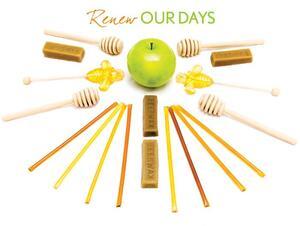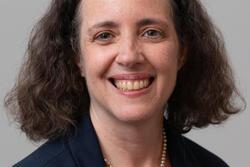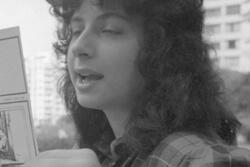The Womb from which the World Came
Originally published as Rosh HaShanah – The Day of Infinite Possibilities on The State of Formation.
Literally translated as the Head of the Year, Rosh Hashanah is known by many names. Yom Ha Zikaron – the Day of Remembrance; Yom T'ruah – the Day the Trumpets Sound; Yom ha Din – the Day of Judgment. It is also known as Hayom Harat Olam – the Day of the World’s Conception. While throughout the machzor [Holiday prayer book] we will refer to God as Ha Melech [the King] and Aveinu Malkeinu [Our father, our king], calling on the strong, powerful, masculine aspects of God.
These are also the days on which we will repeatedly call out God’s attributes, beginning with “Adonai, Adonai, El Rachum v’hanun,” relating to God as the source of rachamim—compassion—the eternal rechem or womb from which the world came—and continually comes—forth.
I have never really paid attention to this name for Rosh Hashanah before, but, because I am currently in my 6th month of pregnancy, the name stood out to me for obvious reasons. I wanted to take the rare and special opportunity of reflecting on Rosh Hashanah while pregnant to explore what insights my pregnancy has afforded me into this unique name for the holiday.
Over the past months I have been reading about what happens when one conceives. It is striking to me how much I didn’t know prior to being pregnant. I learned that pregnancy is actually marked roughly 10 days before fertilization because the body at this point is readying itself for the potential of conception. Before sperm even enters or the egg is released, the body is preparing itself for the possibility of creating new life. In a similar way, during this past month of Elul, the month that precedes Rosh Hashanah, God has been preparing God’s self to receive our intentions and co-create with us in this New Year.
We can map the holiday cycle onto our own cycle. This past month of Elul is a time in our tradition when we prepare ourselves for the possibility of creating some sort of new Life. It is a time when we ready ourselves emotionally, psychologically and spiritually with the idea in mind that today, on Rosh Hashanah, we might conceive—a book, a new course of study, a new career direction, new emotional patterns.
At this time of year, these days of turning and returning, all of life lies before us, the experience of each one sacred. Acknowledging pregnancy loss and infertility struggles that are present in every community, I write on this topic because this pregnancy has informed so much of my spiritual and emotional life over the past year. It has allowed me to realize the way in which we hold all of life in the womb of community, sharing in joy and sorrow, in seeking and striving.
Judaism does not shy away from the pain of these longings on Rosh Hashanah—in fact, it confronts them head on. This year more than ever I am struck by the stories we read about Sarah and Hannah during these two days. During the holiday we read of Sarah’s yearning for a child and her surprise at conceiving even after her cycle had stopped. And of Hannah’s burning desire for a child that, after many years, finally came to be. What connects these stories of barren women yearning for children and the name of Rosh Hashanah as Hayom Harat Olam (the Day of the World’s Conception)?
While the story of Hannah is feasible; perhaps the story of Sarah is more metaphorical. Sarah’s miraculous ability to conceive teaches us that no matter how we see ourselves, as long as we are alive, we possess the ability to bring new creations into the world. Rosh Hashana is a day when conception is much broader than the ability to produce children. This day is one of infinite possibilities where each one of us becomes a vessel for bringing into being that which we most yearn for.
On this day we are invited to open ourselves to that tender and vulnerable place from which our deepest desires arise. We have the opportunity to come into alignment and to release into the universe our intentions for ourselves, for our world, for our year. We challenge ourselves to give over to God and trust in the co-creative partnership that is our faith, without knowing what the outcome will be.
We never know what will come from our conception—of a human, of an idea, of a world. Though we may resist, ignore or look away, once we put the pieces into place we have no choice but to allow what will be…to be. Ehyeh Asher Ehyeh is the name God uses to describe God’s self to Moses, meaning, “I will be that which I will be”. This is the nature of the Divine, of the universe, of new life coming forth. Somehow pregnancy makes this all the more clear. I have no idea who this little being developing inside me is, who they will turn out to be, or if they will turn out to be at all.
The immensity of the lesson of Hayom Harat Olam, the Day of the World’s Conception, is that it’s a mistake to believe we can simply resolve to make something happen when in fact what is required of us is to relax into the vulnerability and to learn to discern the signs and cues that arise to guide us on our life’s path.
And so each year we must return, return, return again, engaging in the act of teshuvah. This is the act of turning back to wholeness with others and within ourselves. It is the act of returning to our relationship with God, of rediscovering creative partnership with the Divine. It is not easy to return, despite the faint calls in the distance beckoning us home. It takes courage and faith to continue to strive towards wholeness and healing, toward the conception of new possibility on this day of beginnings.
Hayom Harat Olam reminds us to gently and lovingly bring ourselves back to God, the eternal mother whose womb is always open and ready for the seed we wish to plant. We enter the world through determination and planning mixed with an utter lack of control and abundant mystery. The process of teshuvah helps us to remember this mix of embrace and surrender, power and vulnerability is the true nature to which we must return.






